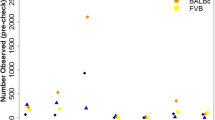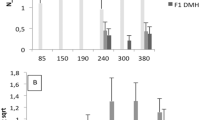Abstract
INBRED strains of mice have been widely used since 1909, and more than 200 distinct strains or sub-strains are now recognized2. In practice, however, although each strain has a unique set of characteristics such as mean life-span, tumour incidence, behaviour, reproductive performance and blood group, different strains may be morphologically indistinguishable. Thus, for example, several of the widely used inbred albino strains cannot easily be told apart from the more common albino randomly bred strains. Unfortunately, although simplified biochemical methods for strain identification have been developed3, they are still too costly and laborious.
This is a preview of subscription content, access via your institution
Access options
Subscribe to this journal
Receive 51 print issues and online access
$199.00 per year
only $3.90 per issue
Buy this article
- Purchase on Springer Link
- Instant access to full article PDF
Prices may be subject to local taxes which are calculated during checkout
Similar content being viewed by others

References
Staats, J., Standardized Nomenclature for Inbred Strains of Mice; Fourth Listing, Cancer Research, 28, 391 (1968).
Biology of the Laboratory Mouse (edit. by Green, E. L.) (McGraw-Hill, London, 1966).
Moutier, R., Biochemical Differences as a Means of Genetic Control for Inbred Strains of Laboratory Animals, Proc. IV ICLA Symposium, Washington, DC (1971).
Grüneberg, H., The Genetics of the Mouse (Martinus Nijhoff, The Hague, 1952).
Stein, K. F., J. Genet., 55, 313 (1957).
Bailey, D. W., J. Hered., 50, 26 (1959).
Blackith, R. E., and Reyment, R. A., Multivariate Morphometrics (Academic Press, London and New York, 1971).
Searle, A. G., J. Genet., 52, 68 (1954).
Parrott, R. F., and Festing, M., Standardised Laboratory Animals, LAC Manual Series No. 2 (MRC Laboratory Animals Centre, Carshalton, Surrey, 1971).
Cooley, W. W., and Lohnes, P. R., Multivariate Data Analysis (John Wiley and Sons, Inc., New York and London, 1971).
Author information
Authors and Affiliations
Rights and permissions
About this article
Cite this article
FESTING, M. Mouse Strain Identification. Nature 238, 351–352 (1972). https://doi.org/10.1038/238351a0
Received:
Revised:
Issue Date:
DOI: https://doi.org/10.1038/238351a0
This article is cited by
-
Genetic analysis of the mandible morphology in DDD.Cg-\(A^{y}\)/Sgn and C57BL/6J inbred mice
Journal of Genetics (2019)
-
Identification of multiple quantitative trait loci affecting the size and shape of the mandible in mice
Mammalian Genome (2009)
-
Genetic quality control in laboratory rodents
Aging Clinical and Experimental Research (1993)
-
Morphometric divergence of Robertsonian populations/species ofMus: A multivariate analysis of size and shape
Experientia (1982)
-
Wrong rodents
Nature (1981)
Comments
By submitting a comment you agree to abide by our Terms and Community Guidelines. If you find something abusive or that does not comply with our terms or guidelines please flag it as inappropriate.


